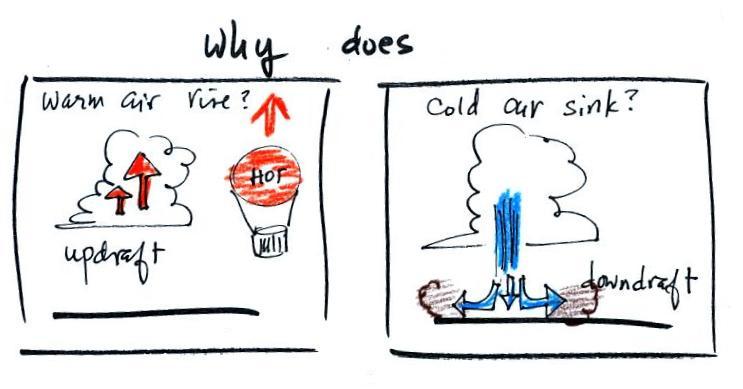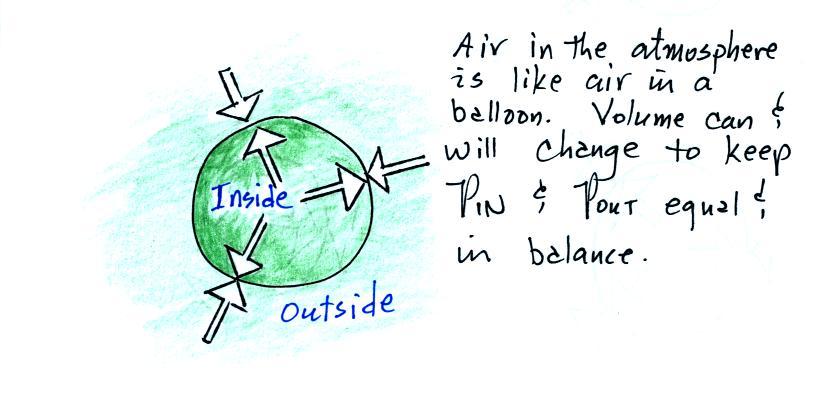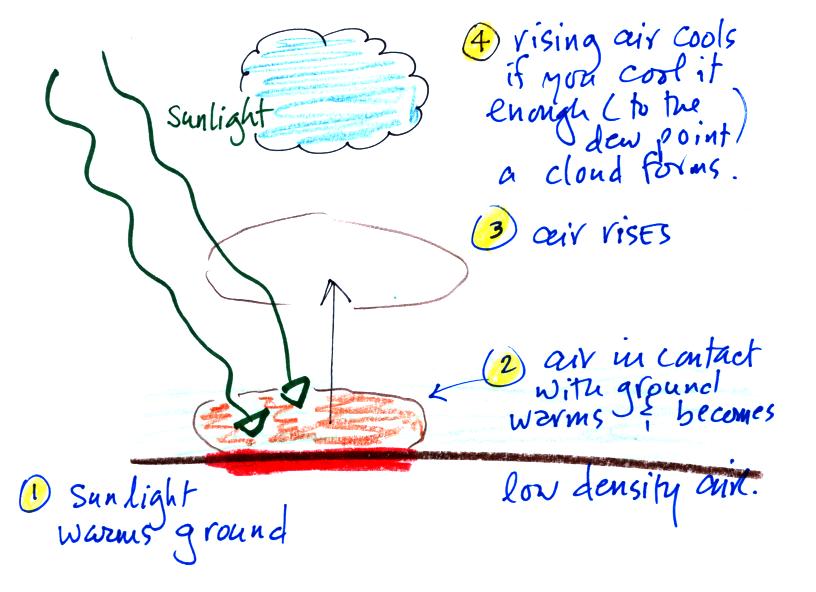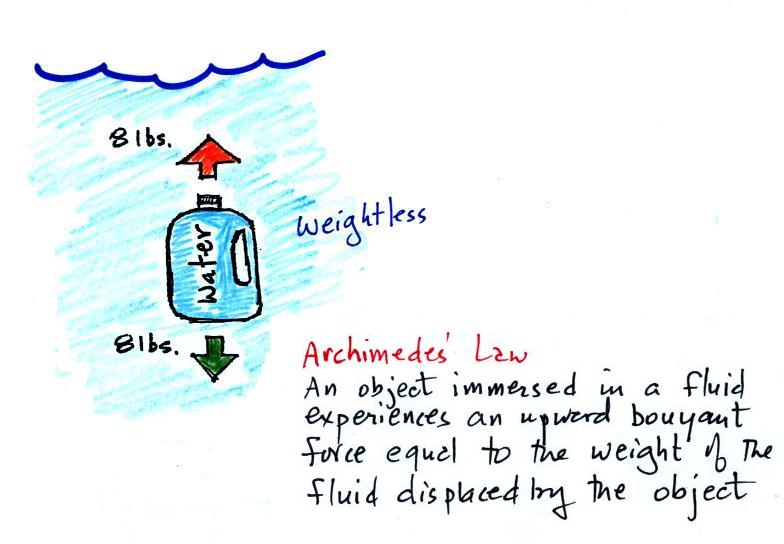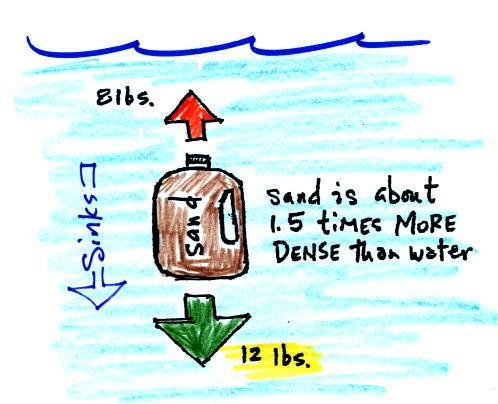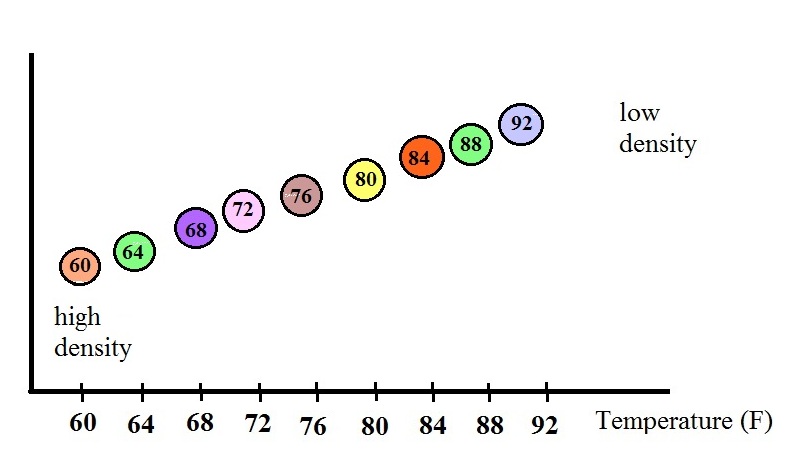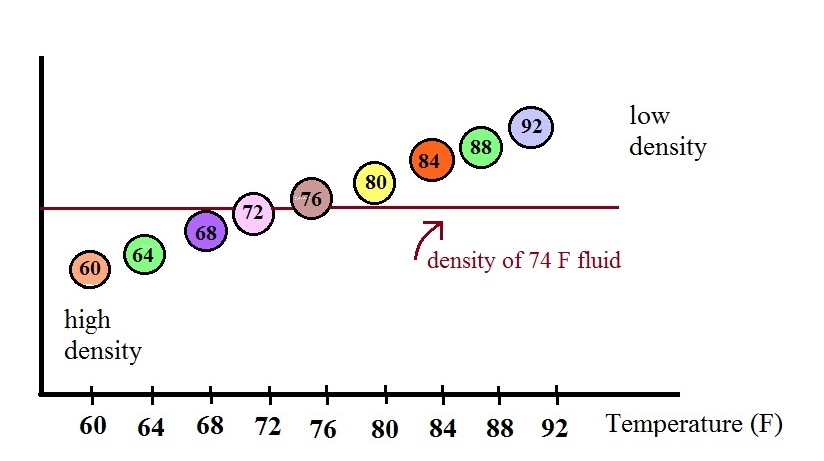
The view on the left is
incorrect.
The air molecules actually do not fill the balloon and
take up all the available space.
|
This is the correct
representation.
The air molecules are moving
around at 100s of MPH but actually take up little or no
space in the balloon.
|

The air molecules are continually colliding
with the walls of the balloon and pushing outward (this force
divided by area is the pressure). Wikipedia
has a
nice animation. An individual molecule doesn't
exert a very strong force, but there are so many molecules
that the combined effect is significant.
What do you need to know about the air inside the balloon to
be able to determine the pressure it produces?

We want to identify the properties or characteristics of
the air inside the balloon that determine the pressure and
then put them together into an equation called the ideal gas
law.
Step #1 - The ideal gas law

In A
the pressure produced by the air molecules inside a
balloon will first depend on how many air molecules are there,
N. If there weren't any air molecules at all there
wouldn't be any pressure.

Here's an example. You're adding
air to a tire. As you add more and more air to something
like a bicycle tire, the pressure increases. Pressure is
directly proportional to N; an increase in N causes an
increase in P. If N doubles, P also doubles (as long as
the other variables in the equation don't change).
In B
air pressure inside a balloon also
depends on the size of the balloon. If you try
to compress and balloon and reduce its volume the air
pressure increases and "fights back." A decrease
in volume causes an increase in pressure, that's an
inverse proportionality.
Note
it is possible to keep pressure
constant by changing N and V together in just the
right kind of way. This is what happens in
Experiment #1 that some students are working on.
Here's a little more detailed look at that experiment.

|
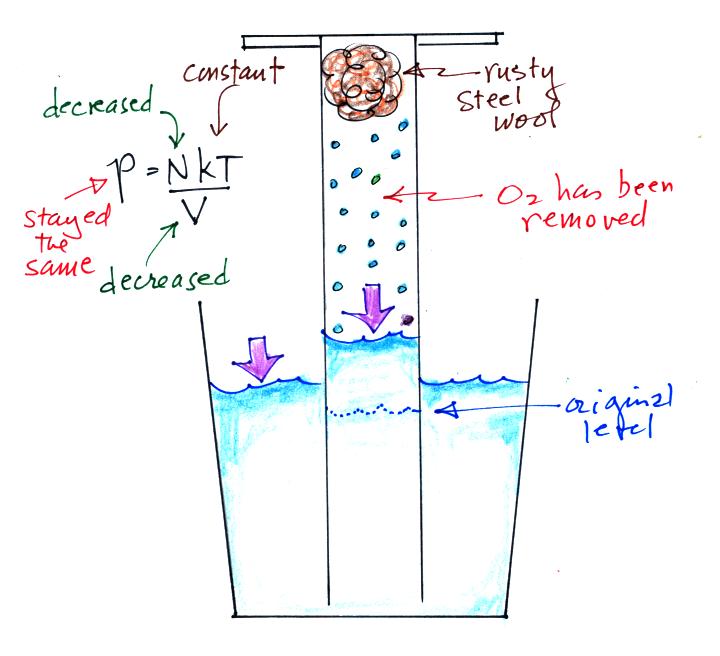
|
An
air sample is trapped together with some steel wool
inside a graduated cylinder. The cylinder is
turned upside down and the open end is stuck into a
glass of water sealing off the air sample from the
rest of the atmosphere. This is shown at left
above. The pressure of air outside the cylinder
tries to push water into the cylinder, the pressure of
the air inside keeps the water out.
Oxygen in the cylinder reacts with
steel wool to form rust. Oxygen is removed from
the air sample which causes N (the total number of air
molecules) to decrease. Removal of oxygen would
ordinarily cause a drop in Pin
and
upsets the balance between Pin
and Pout
. But, as
oxygen is removed, water rises up into the cylinder
decreasing the air sample volume. The decrease
in V causes Pin
to increase. What actually happens is that N and
V both decrease together in the same relative amounts
and the air sample pressure remains constant.
If you were to remove 20% of the air molecules, V would
decrease to 20% of its original value and pressure would stay
constant. It is the change in V that you can measure and
use to determine the oxygen percentage concentration in air.
Part
C: Increasing the temperature of the gas in a
balloon will cause the gas molecules to move more
quickly (kind of like "Mexican
jumping beans"). They'll collide with the
walls of the balloon more frequently and rebound with
greater force. Both will increase the pressure.

You shouldn't
throw a can of spray paint into a fire because the
temperature will cause the pressure inside the can
to increase and the can could explode.
Surprisingly, as explained in Part D, the pressure
does not depend on the mass of the molecules. Pressure
doesn't depend on the composition of the gas. Gas
molecules with a lot of mass will move slowly, the less
massive molecules will move more quickly. The massive
slow moving molecules collide with the walls of the
container with the same force as the smaller ones.
The figure below (which replaces the bottom of p. 51 in
the photocopied ClassNotes) shows two forms of the ideal gas
law. The top equation is the one we just "derived" and
the bottom is a second slightly different version. You
can ignore the constants k and R if you are just trying to
understand how a change in one of the variables would affect
the pressure. You only need the constants when you are
doing a calculation involving numbers and units (which we
won't be doing).

The ratio N/V is similar to density
(mass/volume). That's where the ρ
(density) term in the second equation comes from.
Step #2 Charles' Law
Charles Law requires that
the pressure of a parcel of air remain constant (parcel is
just another word for volume). Changing the
temperature of a volume of air will cause a change in
density and volume; pressure will stay constant.
This is an important situation because this is how volumes
of air in the atmosphere behave.
This is probably the most difficult part of today's class
and is worked out in lots of detail.
We start with a balloon of air. The air
inside and outside the balloon (or parcel) are exactly the
same.
Note the pressure pushing inward is balanced by the
pressure of the air inside the balloon that is pushing
outward. If we change something inside the balloon
that upsets this pressure balance, the balloon would
expand or shrink until the pressures were again in
balance.
Volumes of air in the atmosphere will always try to
keep the pressure of the air inside the parcel constant (P
inside is always trying to stay equal to P outside).
That's why we say air in the atmosphere obeys Charles'
Law.
First let's imagine warming the air inside a
balloon. We'll won't change the temperature of the
air outside the balloon.
Increasing the temperature will momentarily increase
the pressure. This creates an imbalance. Now
that P inside is greater than P outside the balloon will
expand.
Increasing the volume causes the pressure to start to
decrease. The balloon will keep expanding until P
inside is back in balance with P outside.
We're left with a balloon that is larger, warmer, and
filled with lower density air than it was
originally.
The pressures inside and outside are again the
same. The pressure inside is back to what it was
before we warmed the air in the balloon. You can
increase the temperature and volume of a parcel together
in a way that keeps pressure constant (which is what
Charles' law requires). Or you can increase the
temperature and decrease the density together and keep the
pressure constant.
In nature the change in temperature and volume occur
simultaneously. It's like jumping from the first to
the last step above.
We can go through the same kind of reasoning and see what
happens if we cool the air in a parcel. I've
included all the steps below; that
wasn't done in class.
We'll start with a parcel of air that has the same
temperature and density as the air around it.
We'll cool the air inside the parcel. The air
outside stays the same.
Reducing the air temperature causes the pressure of the
air inside the balloon to decrease. Because the
outside air pressure is greater than the pressure inside
the balloon the parcel is compressed.
The balloon will get smaller and smaller (and the
pressure inside will get bigger and bigger) until the
pressures inside and outside the balloon are again
equal. The pressure inside is back to the value it
had before you cooled the air in the parcel.
The first and last steps, without all the intermediate
and momentary details, are shown below.
Cooling some air will cause volume to decrease and
density to increase while pressure stays constant.
If you want to skip all the details and just remember
one thing, here's what I'd recommend
Parcels of atmospheric air and air in balloons behave the
same way, they both obey Charles' Law. Charles
Law can be demonstrated by dipping a balloon in liquid
nitrogen. You'll find an explanation on the top of
p. 54 in the photocopied ClassNotes.
The balloon shrinks down to practically nothing when
dunked in the liquid nitrogen. It is filled with
very cold, very high density air. When the balloon
is pulled from the liquid nitrogen and starts to warm up
it expands. Density in the balloon decreases.
The volume and temperature keep changing in a way that
kept pressure constant (pressure inside the balloon is
staying equal to the air pressure outside the
balloon). Eventually the balloon ends up back at
room temperature (unless it pops while warming up).
Step #3 Vertical forces acting on
parcels of air
And finally the last step toward
understanding why warm air rises and cold air sinks.
We'll have a look at the forces that act on parcels of air in
the atmosphere. This is something we have
already covered. The information below is found on p. 53
in the photocopied ClassNotes.
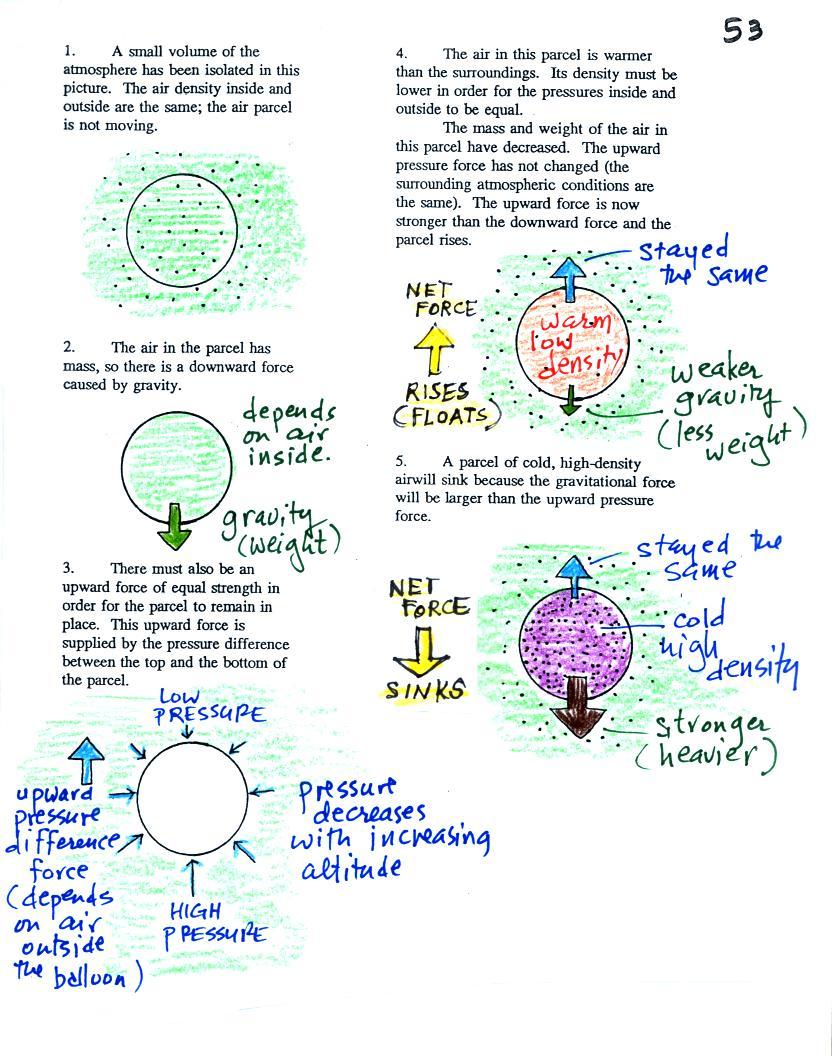
Basically it comes down to this - there are two forces acting
on a parcel of air in
the atmosphere. They are shown on the left
hand side of the figure above.
The first force is gravity, it pulls downward. The
strength of the gravity force (the weight of the air in the
parcel) depends on the mass of the air inside the
parcel.
Second there is an upward pointing pressure difference
force. This force is caused by the air outside
(surrounding) the parcel. Pressure decreases with
increasing altitude. The pressure of the air at the
bottom of a parcel pushing upward is slightly stronger than
the pressure of the air at the top of the balloon that is
pushing downward. The overall effect is an upward
pointing force.
When the air inside a parcel is exactly the same as the air
outside, the two forces are equal in strength and cancel
out. The parcel is neutrally buoyant and it wouldn't
rise or sink, it would just sit in place.
Now have a look at the right hand side of the figure.
If you replace the air inside the balloon with warm low
density air, it won't weigh as much. The gravity force
is weaker. The upward pressure difference force doesn't
change (because it is determined by the air outside the
balloon which hasn't changed) and ends up stronger than the
gravity force. The balloon will rise.
Conversely if the air inside is cold high density air, it
weighs more. Gravity is stronger than the upward
pressure difference force and the balloon sinks.
It all comes down to how the density of the in parcel
compares to the density of the air surrounding the
parcel. If the parcel is filled with low density air it
will rise. A parcel full of high density air will sink.
We did a short demonstration to
show how density can determine whether an object or a parcel
of air will rise or sink.

We used balloons filled with helium (see bottom of
p. 54 in the photocopied Class Notes). Helium is less
dense than air even when it has the same temperature as the
surrounding air. The downward gravity force (weight of
the helium filled balloon) is weaker than the upward pressure
difference force. A helium-filled balloon doesn't need
to warmed up in order to rise.
We dunk the helium filled balloon in liquid nitrogen to cool
it off and make it denser than air. When you pull the
balloon out of the liquid nitrogen the helium is cold and
denser than the surrounding air. I set it on the table (dark
blue above).
As the balloon of helium warms and expands its density
decreases (light blue). For a brief moment it has the
same density as the surrounding air (green). It's
neutrally buoyant at this point. Then it warms back to
near room temperature where it is again less dense than the
air and lifts off the table (yellow).
Free convection
Something like this happens in the atmosphere. I didn't
show the following picture in class.
Sunlight shines through the atmosphere. Once it reaches
the ground at (1) it is absorbed and warms the ground.
This in turns warms air in contact with the ground (2)
As this air warms, its density starts to decrease. When
the density of the warm air is low enough, small "blobs" of
air separate from the air layer at the ground and begin to
rise, these are called "thermals." (3) Rising air
expands and cools (we've haven't covered this yet and it might
sound a little contradictory). If it cools enough (to
the dew point) a cloud will become visible as shown at Point
4. This whole process is called convection; many of our
summer thunderstorms start this way.
Archimedes' principle
Here's another way of trying to understand why warm air rises
and cold air sinks - Archimedes Law or Principle. It's
a perhaps simpler way of understanding the topics. A
bottle of water can help you to visualize the law.
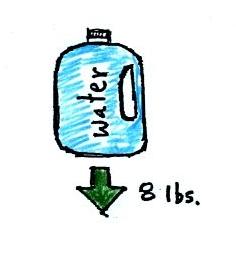
A gallon of water weighs about
8 pounds (lbs). I wouldn't want to carry that much water
on a hike unless I really thought I would need it.
If you submerge the gallon jug of water in a swimming pool,
the jug becomes, for all intents and purposes,
weightless. That seems kind of amazing.
Archimedes' Law (see figure below, from p. 53a in the
photocopied ClassNotes) explains why this is true.
Archimedes first of all tells you that the surrounding
fluid will exert an upward pointing buoyant force on the
submerged water bottle. That's why the submerged jug can
become weightless.
Archimedes law also tells you how to figure out how strong the
buoyant force will be. In this case the 1
gallon bottle will displace 1 gallon of pool water. One
gallon of pool water weighs 8 pounds. The upward buoyant
force will be 8 pounds, the same as the downward force.
The two forces are equal and opposite.
What Archimedes law doesn't really tell you is what causes
the upward buoyant force. You should know what the force
is - it's the upward pressure difference force.
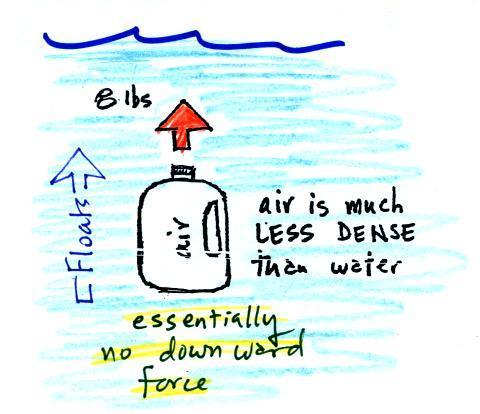
|
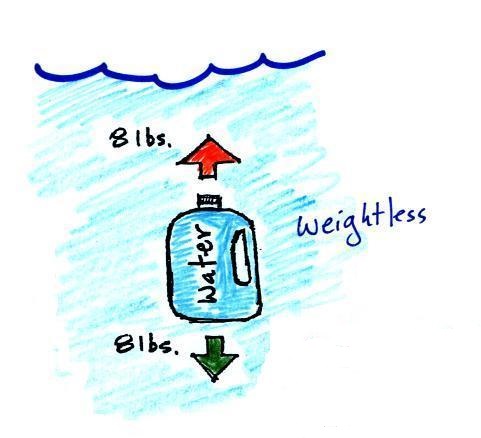
|
We've poured out the water and filled
the 1 gallon jug with air. Air is much less dense
than water; compared to water, the jug will weigh
practically nothing. But it still displaces a
gallon of water and experiences the 8 lb. upward buoyant
force. The bottle of air would rise (actually it
shoots up to the top of the pool).
|
A bottle filled with water is
weightless. The density of the material inside and
outside the bottle are the same.
|
I wish I could get my hands on a gallon of mercury but I
can't (and am not sure I'd be able to carry it to class even
if I could)
|
 |
Sand is about 50% denser than
water. The weight of a gallon of sand is more
than a gallon of water. The downward force is
greater than the upward force and the bottle of sand
sinks.
|
A gallon of water immersed in
water is weightless.
|
Y
ou can sum all of this up by saying anything that
is less dense than water will float in water, anything that
is more dense than water will sink in water.
Most types of wood will float (ebony and
ironwood will sink). Most rocks sink (pumice is an
exception).
The same reasoning applies to air in the atmosphere
though it's harder to appreciate because air is
invisible. When we say immersed in a fluid the fluid
can be a liquid like water or a gas like air.

Air that is less dense (warmer) than the air around it will
rise. Air that is more dense (colder) than the air
around it will sink.
Here's a little more
information about Archimedes that I didn't mention in
class.
There's a colorful demonstration that shows how small
differences in density can determine whether an object floats
or sinks.
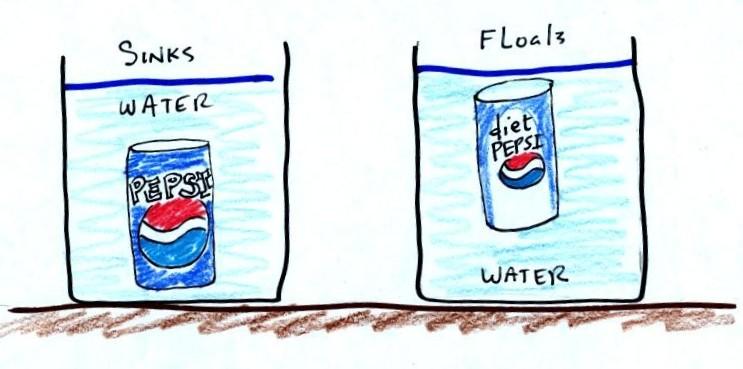
A can of regular Pepsi was
placed in a beaker of water. The can sank. A can
of Diet Pepsi on the other hand floated.
Both cans are made of aluminum which has a density almost
three times higher than water; aluminum by itself would
sink. The drink itself is largely water. The
regular soda also has a lot of high-fructose
corn syrup, the diet soda doesn't. The mixture
of water and corn syrup has a density greater than plain
water. There is also a little air (or perhaps carbon
dioxide gas) in each can (the diet soda probably wouldn't
float if it weren't for the gas in the can.
The average density of the can of regular soda (water
& corn syrup + aluminum + air) ends up being slightly
greater than the density of water. The average density
of the can of diet soda (water + aluminum + air) is slightly
less than the density of water.
In some respects people in swimming pools are like cans
of regular and diet soda. Some people float (they're a
little less dense than water), other people sink (slightly
more dense than water).

I wanted to show one last application of
some of what we have been learning - a Galileo
thermometer. It's a new acquisition of mine and fairly
fragile. I keep it in a fairly secure location in my
office and forgot to put it into its box for transport to
class. I brought the box but when I opened it before
class the thermometer wasn't there. I'll bring it next
Tuesday.
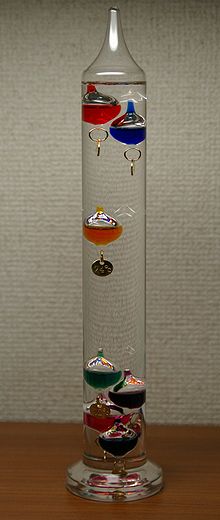
The figure above comes from an
interesting and informative article in Wikipedia.
The fluid in the thermometer will expand slightly if it
warms. It will shrink when it cools.
The changes in the volume of the fluid will change the fluid's
density. The graph above shows how the fluid density
might change depending on temperature. Note lower
densities are found near the top of the graph.
The colored balls in the thermometer
all have slightly different densities. They also have
little temperature tags. The 60 F ball has a density
equal to the density of the fluid at 60 F. The 64
F ball has a slightly lower density, the density of the fluid
when it has warmed to 64 , and so on.
In use the density of the fluid in the thermometer
will change depending on the temperature. The densities
of the balls remain constant. As an example we will that
the fluid in the thermometer has a temperature of 74 F.
The 60, 64, 68, and 72 F balls will all have densities higher
than the fluid (they lie below the 74F line in the graph
above) and will sink. The remaining balls have densities
lower than the fluid and will float.
